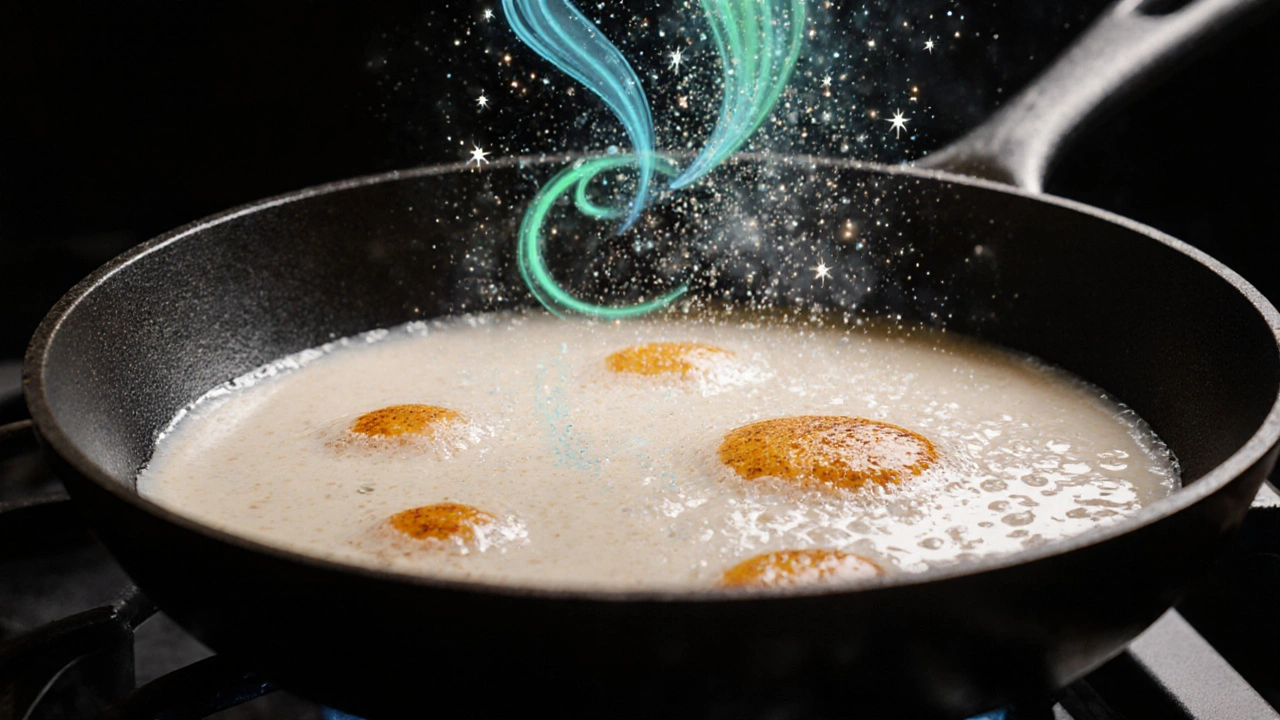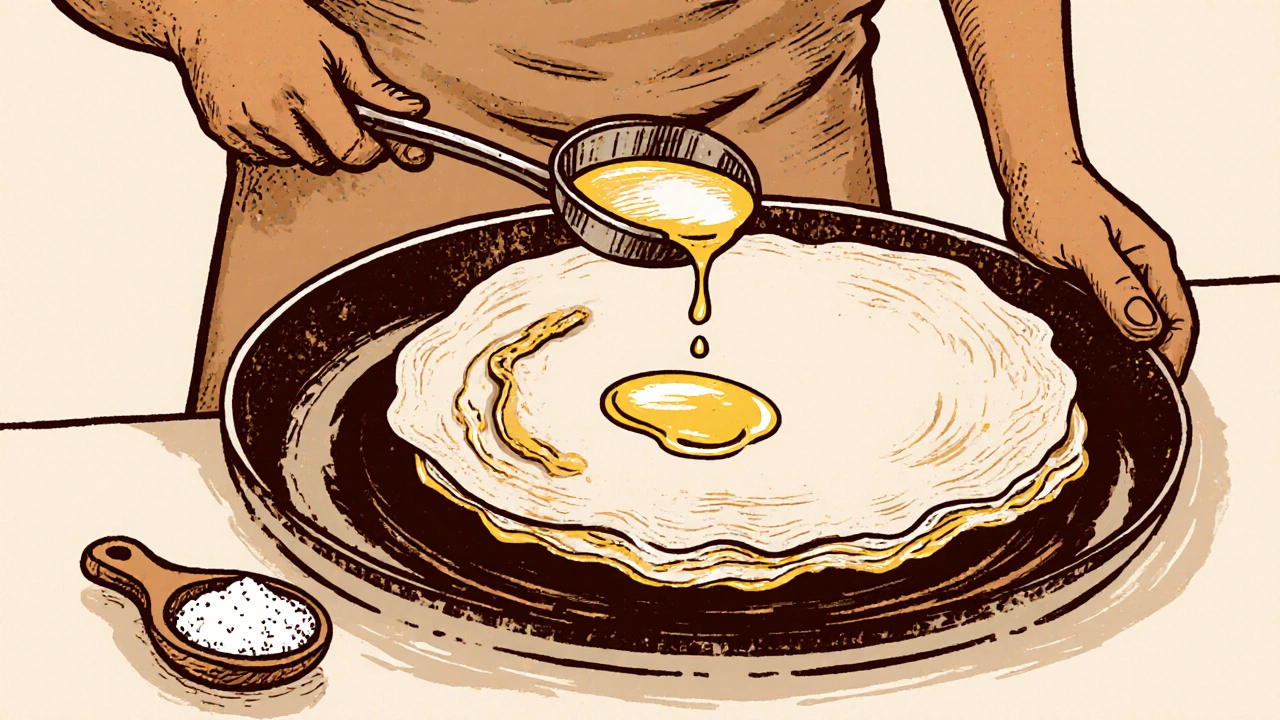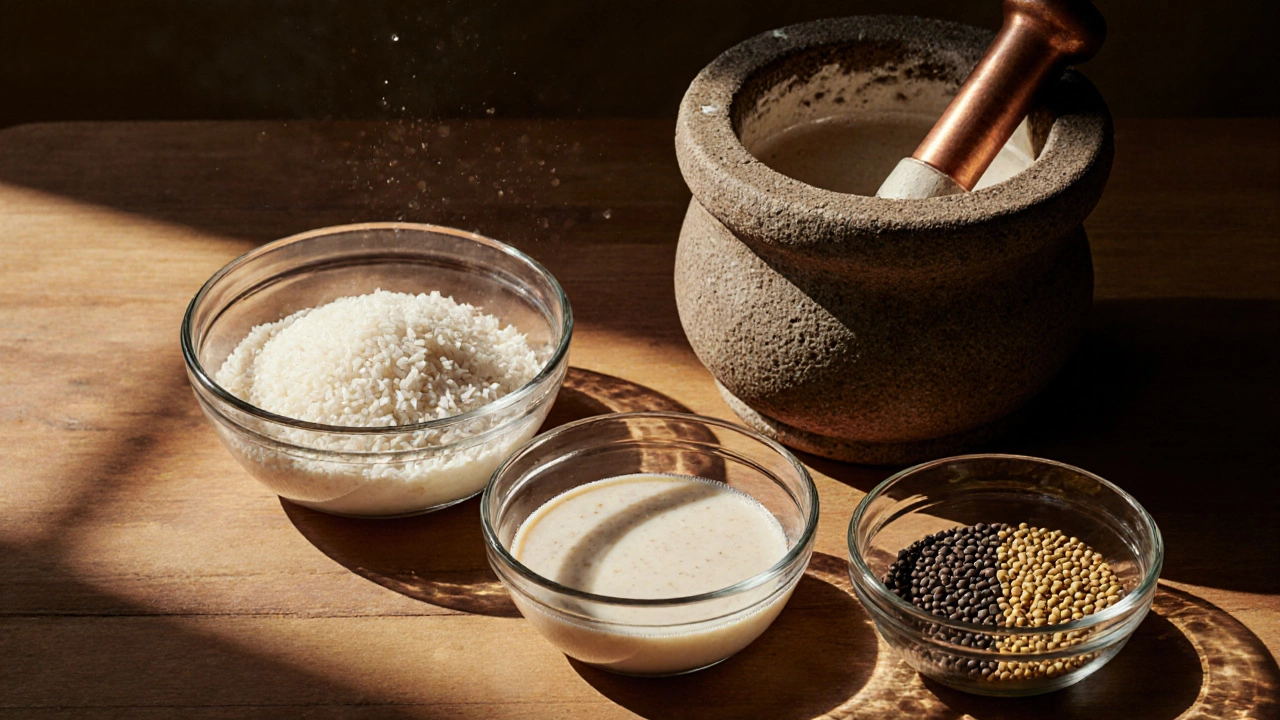Dosa Batter Soda Calculator
Calculate Baking Soda Amount
For perfect crispiness without bitterness
Recommended Baking Soda
Important: Do not exceed 1 teaspoon for 2 cups rice. More than 1 tsp may cause bitter taste.
Ever wondered why a pinch of soda shows up in many dosa batter recipes? That tiny ingredient can be the difference between a flat, soggy pancake and a golden, crisp masterpiece. This guide breaks down the science, the right amounts, and the common hiccups so you can master the perfect dosa every time.
What Exactly Is Dosa Batter?
When preparing Dosa batter is a fermented mixture of rice and urad dal used to make thin, crispy South Indian pancakes, the base ingredients are usually soaked rice, split black gram (urad dal), and a bit of fenugreek seed. After grinding into a smooth slurry, the batter sits at room temperature for 8‑12hours, allowing natural microbes to ferment.
Fermentation does three things: it creates the signature tangy flavor, breaks down complex carbs for easier digestion, and produces tiny air pockets that help the dosa puff up on the pan.
The Chemistry Behind Baking Soda
Enter baking soda (sodium bicarbonate) is an alkaline powder that releases carbon dioxide when it reacts with an acid or heat. In the context of dosa batter, it acts as a rapid leavening agent, giving an extra lift that the natural fermentation sometimes can’t achieve on its own.
When the batter’s pH rises, the protein structure of the rice and dal weakens a bit, allowing more air to stay trapped during cooking. The result is a lighter, crisper surface and a softer interior.
Why Home Cooks Add Soda to the Batter
- Boosted crispiness - The alkaline environment encourages Maillard browning, so the dosa gets those delightful brown spots faster.
- Consistent rise - Natural fermentation can be fickle; temperature swings or a weak starter may leave the batter flat. Baking soda guarantees a reliable puff.
- Shorter fermentation time - If you’re short on time, a pinch of soda lets you achieve a similar texture in half the time.
- Balanced flavor - The slight alkaline taste counteracts excessive sourness, giving a milder, more approachable flavor for those unfamiliar with fermented foods.
That’s why many modern recipe books, especially those aimed at busy urban kitchens, recommend a small amount of soda along with the traditional overnight ferment.

How Much Soda Should You Use?
The key is moderation. Too much soda can give the dosa a bitter, metallic aftertaste and make it overly airy-think of a souffle rather than a crepe. A good rule of thumb is:
- For 2cups of dry rice (about 500ml of ground batter), add ½teaspoon (≈2g) of baking soda.
- If you’re using a pre‑fermented batter that’s already bubbly, reduce the amount to ¼teaspoon.
- Mix the soda in after the batter has completed its primary fermentation, just before heating the pan.
Stir gently; vigorous mixing can deflate the trapped gases you’ve just created.
Alternatives to Baking Soda
Not everyone wants to reach for the pantry soda can. Here are other ways to boost your dosa’s texture:
- Lemon or lime juice - Adds acidity that encourages fermentation and creates a slight tang, but you’ll need a bit more time for the batter to rise.
- Yogurt or buttermilk - Their natural cultures and slight acidity improve fluffiness while keeping the batter dairy‑rich.
- Longer fermentation - Simply letting the batter sit for 14‑16hours at a warm spot (≈30°C) can achieve the same airiness without any chemicals.
- Fermentation starters - Some cooks add a spoonful of ready‑made dosa batter from a previous batch to jump‑start the process.
Each method changes the flavor profile a bit, so experiment to find what you enjoy most.

Typical Pitfalls and How to Fix Them
Even with the right amount of soda, things can go wrong. Below are common issues and quick fixes:
| Problem | No Soda | With Soda |
|---|---|---|
| Flat, soggy dosa | Common if batter is under‑fermented | Usually resolved; batter puffs better |
| Bitter aftertaste | Rare | Occurs if >1tsp used for 2cups rice |
| Uneven browning | Can happen on low heat | Alkaline environment promotes even Maillard reaction |
Fixes:
- Flatness: Increase soda by ¼tsp or extend fermentation by 2‑3hours.
- Bitter taste: Cut the soda in half next time, and rinse the pan briefly before the next batch.
- Uneven browning: Ensure the pan is properly heated (medium‑high) before pouring batter.
Quick Checklist Before You Cook
- Soak rice and urad dal for at least 4hours.
- Grind to a smooth, slightly thick batter (about the consistency of plain yogurt).
- Ferment at 25‑30°C for 8‑12hours; look for bubbles and a subtle sour smell.
- Just before cooking, add the measured soda in dosa batter and stir gently.
- Heat a non‑stick or cast‑iron tava to medium‑high; a drop of batter should sizzle immediately.
- Spread batter thinly, drizzle a few drops of oil, and cook until edges lift and spots turn golden.
Mini FAQ
Can I use baking powder instead of soda?
Baking powder contains both acid and base, so it will add leavening but also alter the taste. It’s better suited for baked goods; for dosa, plain baking soda gives a cleaner, crisper result.
Is soda safe for kids?
Yes, in the tiny amounts used for dosa (½‑¼tsp per batch) it’s perfectly safe. The sodium content is negligible compared to daily dietary intake.
What if I forget to add soda?
Your dosa will still be edible but may be softer and less crisp. You can compensate by cooking a bit longer or using a hotter pan.
Does soda affect the health benefits of dosa?
The impact is minimal. The primary health perks-probiotic benefits from fermentation and low‑fat cooking-remain intact.
Can I add soda to gluten‑free dosa batter?
Absolutely. Soda works the same way with rice‑only batters. Just follow the same ratios for best results.
Now you’ve got the full picture: why soda is added, how much to use, and what to do if things go sideways. Next time you crank up the stove, you’ll know exactly why that pinch of soda makes the difference between a limp crepe and a perfectly crisp dosa.
